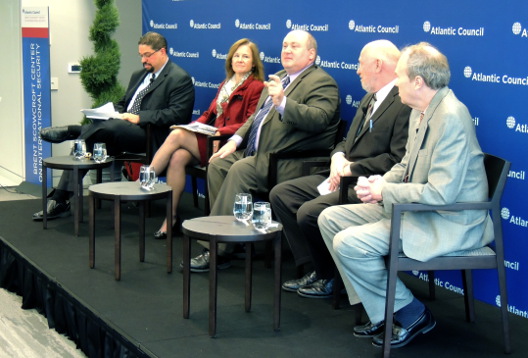 The future of global development is dependent on connecting people with diverse expertise and making futures analysis at the policy level implementable on the ground, concluded a panel of experts speaking at the Atlantic Council on December 17 for a public event on “Building the Future of Global Development.” The event also marked the official launch of The Future Can’t Wait(PDF), a collection of ten essays from leading futures thinkers and the outcome of USAID’s first-ever Symposium on Future Development Challenges held in November 2011 – cohosted by the US Department of State, the National Defense University, and the Woodrow Wilson International Center for Scholars.
The future of global development is dependent on connecting people with diverse expertise and making futures analysis at the policy level implementable on the ground, concluded a panel of experts speaking at the Atlantic Council on December 17 for a public event on “Building the Future of Global Development.” The event also marked the official launch of The Future Can’t Wait(PDF), a collection of ten essays from leading futures thinkers and the outcome of USAID’s first-ever Symposium on Future Development Challenges held in November 2011 – cohosted by the US Department of State, the National Defense University, and the Woodrow Wilson International Center for Scholars.
The event included welcoming remarks by Atlantic Council Vice President and Director of the Brent Scowcroft Center on International Security Barry Pavel and introductory remarks from US Agency for International Development (USAID) Associate Administrator Mark Feierstein.
Mr. Pavel reflected on the conversations at the 2013 Strategic Foresight Forum: Harnessing Disruption, where speakers explored the theme of harnessing technological disruption to be better prepared for an uncertain future. He shared that foreign aid will also have to contend with harnessing disruption caused by emerging technologies when tackling the challenges of constrained resources, extreme climate, rural/urban migration, and major political shifts.
Mr. Feierstein emphasized how the wide proliferation of emerging technologies, such as 3D printing, will continue to revolutionize and significantly alter traditional approaches to the administration of foreign aid. He stated that by 2014, we will have more cell phones than people – more than roughly seven billion devices connecting distant parts of the world to powerful information at the click of a button. Not only will the foreign aid community have to build a network of partners, it will have to utilize common technologies and platforms for everything from helping build a small business to hastening disaster response.
Expanding upon these comments, a panel of experts discussed the role of the nation state in aid, integrated partnership approaches, and making foresight actionable. Moderated by the Wilson Center’s Director of the Population, Environmental Change, and Security Program and the Global Health Initiative Roger-Mark De Souza, the panel consisted of: the Atlantic Council’s Strategic Foresight Initiative Director Mathew J. Burrows, Wilson Center Global Fellow and Stimson Center Demographer-in-Residence Richard Cincotta, Ohio University Director of Environmental Studies in the Voinovich School Geoffrey Dabelko, and USAID Counselor Susan Reichle.
Some key takeaways from the panel include:
- The Future Can’t Wait is a step in the right direction for USAID and for the practice of futures analysis as it emphasizes making foresight actionable
- In tackling the troubles caused by climate change, “the periphery isn’t peripheral” – knowledge from disparate environments must be integrated
- Demographics are not deterministic but help project key trends and patterns which can better prepare aid organizations and governments for future crises
- Even with a plethora of nongovernmental entities working on development, government assistance and strategic planning can’t be discounted in administering aid
All in all, despite the challenges the development community faces, connecting the aid community and integrating futures analysis into aid administration will help perpetuate the successes of global development (reducing childhood mortality, continued empowerment and education of women, etc.) well into the future.
